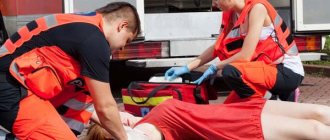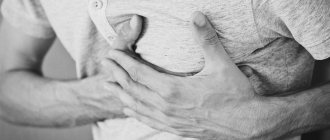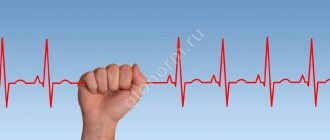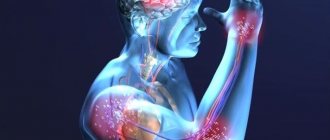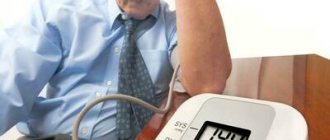Authors:
Chad A Asplund, Francis G O'Connor, Timothy D Noakes.
Translation
- Sergei Strukov.
Endurance sports are growing in popularity. In 2010, more than 500 thousand people took part in marathon races (1). One study showed that for every 1000 finishers, ~25 people needed medical care; however, their abundance is closely related to the environment (2, 3). Exercise-related collapse (EAC) is the most common condition among runners requiring medical attention, accounting for 59–85% of presentations after marathons and ultramarathons (2, 4).
The mechanism of CFN is multifactorial and has previously been attributed to overheating or dehydration ( 5 – 7 ). Currently, the main cause of CRF is considered to be transient postural hypotension, after the athlete stops running, caused by the outflow of blood to the lower extremities and leading to impairment of cardiac baroreflexes (8, 9). The purpose of this article is to review the available scientific evidence to better explain CPT in order to provide clinicians with the best treatment methods and evidence-based algorithm for working on competition day.
Definitions
Exercise-related collapse
Collapse in athletes unable to stand or walk unassisted as a result of mild dizziness, weakness and dizziness, or syncope caused by collapse occurring after the end of exertion or cessation of exercise (11).
Exercise-induced postural hypotension
Symptoms after exercise caused by a decrease in systolic blood pressure of more than 20 mm Hg. Art. from taking a vertical position from a supine position (4).
Orthostatic intolerance
Symptoms caused by orthostatic hypotension from a decrease in systolic blood pressure of more than 20 mmHg. Art. or diastolic blood pressure by 10 mm Hg. Art. for three minutes of standing (12).
EPH, exercise-related postural hypotension (EPH), and orthostatic intolerance (IO) all cause syncope or presyncope, but EPH and EPH are specific to exercise. PGFN differs from CFN in the measurement of blood pressure and differences in the supine and standing positions. However, PGFN and KFN describe collapse in athletes after physical exertion.
Emergency care for orthostatic collapse
At the first signs of orthostatic collapse, you must:
- Tilt the patient's head back.
- If orthostatic collapse was caused by bleeding, then take all measures to stop it.
- Call an ambulance.
- Provide fresh air flow.
- Cover the patient with warm heating pads.
- Remove clothing that restricts breathing.
- Sprinkle the patient's face and chest with cold water.
- Bring a cotton swab moistened with ammonia to the patient’s nose.
- Rub the limbs with a hard cloth or brush.
- If possible, inject subcutaneously Cordiamine 1-2 ml or a solution of 10% Caffeine 1 ml.
- After regaining consciousness, give the patient warm tea or coffee with sugar.
During orthostatic collapse, you should not give the patient vasodilators (No-Shpa, Papaverine, Valocordin, etc.) and try to bring him to his senses by hitting his cheeks.
Heat stroke and hyponatremia
Exertional heat stroke (EHS) is characterized by dysfunction of the central nervous system, which may manifest as collapse or syncope associated with an increase in core body temperature (>400 C) caused by exercise (13, 14). Exercise hyponatremia (EH) is a potentially life-threatening condition characterized by decreased serum sodium (<135 mmol/L) and changes in mental status. Athletes with HFN present with actual syncope, confusion, or disorientation, but with changes in serum sodium concentration (15).
HFN and PHFN may be a cause of collapse in endurance sports, but they are associated with abnormal vital signs/symptoms and should be suspected and ruled out before diagnosing HFN. This review focuses on CFN, its mechanism and treatment; therefore, TUFN and GFN will not be discussed further.
Drugs to relieve an attack
The main goal of emergency care for collapse is to increase blood volume. Saline solution does an excellent job of this.
However, it is contraindicated in cardiogenic shock due to the possible development of pulmonary edema. In this case, it would be appropriate to use norepinephrine, a pressor amine. Unlike sodium chloride solution, which is administered by stream, alpha-agonists are administered intravenously by drip.
Occasionally, dopamine is used instead of norepinephrine. It constricts the blood vessels of the muscles and skin well, but at the same time dilates the blood vessels of the internal organs.
All drugs are infused intravenously - administering the medicine intramuscularly or subcutaneously makes no sense due to collaptoid circulatory pathologies in the tissues.
KFN mechanism
Endurance training causes an increase in cardiac output and volume load on the left and right ventricles, resulting in an endurance-trained heart with a dilated and moderately thickened left ventricular wall. An increase in cardiac output from training is accompanied by a decrease in heart rate in trained athletes compared to untrained ones. In addition, when performing exercises, active muscles of the lower extremities require increased blood flow, which means that a decrease in peripheral vascular resistance is necessary to meet the demand. To produce this significant cardiac output and counteract the decrease in resting heart rate secondary to the effects of training, athletes must increase stroke volume and vascular resistance. Active skeletal muscles act as a “second heart,” allowing blood to return to the heart from the dilated vessels of the lower extremities. After cessation of activity, the second heart no longer contributes to venous return, a significant volume of blood is retained in the lower extremities and can cause CRF. Therefore, adaptations leading to successful endurance activities are also a significant factor in the increase in OH that is observed in endurance athletes.
According to scientific data, trained athletes have an increased tendency to develop ON. Studies support the concept of decreased resistance of the leg and lower extremity, increased compliance and the ability to expand the diastolic chamber as factors leading to ON in athletes (16 – 18). Left ventricular end-diastolic volume increases more in endurance athletes than in non-athletes. This is necessary to produce a larger stroke volume (19). Also, trained athletes exhibit a decrease in ventricular unwinding rate compared with untrained athletes, demonstrating the ability of the trained heart to adapt to maintaining high cardiac output (20). The increase in vascular volume from exercise, associated with changes in cardiac filling and output volume, may lead to a re-adjustment of the cardiopulmonary baroreflex (22). Because of baroreflex resetting, trained individuals may be more dependent on maintaining venous return when upright after exercise (23). Finally, a critical review supports exercise-induced increases in stroke volume as a compensatory mechanism against ON (Table 1).
Prevention
To prevent orthostatic collapse, the following is necessary:
- Moderate food intake, with limited carbohydrates, is especially recommended for patients who experience orthostatic collapse after eating.
- A gradual change in body position from horizontal to vertical, especially if orthostatic hypotension occurs after standing up abruptly.
- Constant moderate physical activity in the fresh air, if orthostatic hypotension has developed due to weakness of the autonomic nervous system. This especially applies to children, in whom attacks of orthostatic hypotension are temporary and go away with age and strengthening of the nervous system.
- Clinical observation, control of chronic diseases causing orthostatic hypotension.
The role of heat and dehydration
Dehydration causing hyperthermia has been implicated as a major contributor to CFI (5–7), but there is no evidence to support its overall responsibility for ON or CFI in endurance athletes (25). However, existing evidence supports that heat stress and elevated skin temperature are contributing factors to ON. Heat stress leads to decreased baroreflex control of the response to orthostatic stress (26). Heat stress is also thought to impair aerobic exercise performance, primarily by increasing cardiovascular strain (27). In addition, an increase in body temperature may increase cerebral vascular resistance, lowering the cerebral threshold for neurogenic collapse (28).
Table 1. Mechanisms
| Source | Author/magazine | Year | Type of study | Patients | Result | UD |
| 16 | Morikawa et al Med Sci Sports Exerc | 2001 | Controlled test | 26 runners, 23 peers, control | Trained women with a high level of orthostatic intolerance in ADNT. Increasing vascular compliance plays an important role | 2 |
| 17 | Levine et al Circulation | 1991 | Controlled test | 7 athletes and 6 control group | Endurance athletes have greater diastolic chamber compliance and distensibility than non-athletes | 2 |
| 18 | Levine et al J Appl Physiol | 1991 | Controlled test | 8 high trained, 8 moderate trained and 8 low trained | Calf vascular compliance and carotid baroreflex response contribute to individual response to LBNT | 2 |
| 19 | Esch et al Am J Physiol Heart Circ Physiol | 2007 | Controlled test | 8 athletes and 8 control group | Endurance athletes have a greater increase in end-diastolic volume than non-athletes, with a similar area of the right ventricular cavity | 2 |
| 20 | Esch et al J Appl Physiol | 2010 | Controlled test | 8 athletes and 8 control group | Endurance athletes have a reduced rate of left ventricular untwisting compared to non-athletes | 2 |
| 21 | Convertino Med Sci Sports Exerc | 2003 | Controlled test | 8 men | Vascular expansion is associated with a decrease in heart rate response to baroreflex stimulation | 2 |
| 22 | Ogoh et al J Appl Physiol | 2006 | Controlled test | 8 men | The cardiopulmonary baroreflex is readjusted to a new operating point associated with the exercise-induced change in ventricular filling volume | 2 |
| 23 | Ogoh et al J Physiol | 2003 | Controlled test | 14 men | Highly trained individuals rely more on maintaining venous return to maintain an upright body position | 2 |
| 24 | Convertino Med Sci Sports Exerc | 1993 | Critical review | — | Increasing stroke volume is the primary compensation mechanism in endurance-trained individuals. | 3 |
| NPLP – negative pressure in the lower part of the body; LE – level of evidence. | ||||||
Two small studies have found changes in baroreflex control of blood pressure in individual subjects from laboratory-induced hypovolemia, which increases sensitivity to CFP (22, 29). However, a larger body composition-controlled clinical study of 31 ultra-marathon runners did not find higher temperatures in subjects with collapse compared to those without collapse. All runners were dehydrated, but the amount of dehydration was not related to the degree of postural hypotension after the event (30) (Table 2). Therefore, heat and dehydration have not been recognized as the true causes of CFI or ON in endurance events, but they may be risk factors for CFI or contribute to impaired peripheral vasoconstriction leading to an orthostatic state.
Table 2. Dehydration/heat
| Source | Author\magazine | Year | Type of study | Patients | Result | UD |
| 23 | Ogoh et al J Physiol | 2003 | Clinical trial | 14 men | During endurance training, the baroreflex is weakened in response to a progressive decrease in central blood volume. | 2 |
| 26 | Crandall Am J Physiol Heart Circ Physiol | 2000 | Controlled test | 12 people | Decreased baroreflex, along with decreased ability to increase heart rate, increases sensitivity to OH | 2 |
| 27 | Cheuvront et al J Appl Physiol | 2010 | Critical review | — | Dehydration increases hyperthermia and decreases plasma volume, which increases cardiovascular stress | 3 |
| 28 | Wilson et al Am J Physiol Regul Integr Com Physiol | 2006 | Controlled test | 15 men | Heat stress reduces cerebral blood flow velocity and increases cerebral vascular resistance | 2 |
| 29 | Charkoudian et al J Physiol | 2003 | Controlled test | 13 healthy people | Exercise-induced dehydration leads to changes in baroreflex control of blood pressure | 2 |
| 30 | Holtzhausen et al Med Sci Sports Exerc | 1995 | Clinical trial | 31 runners | All runners had a decrease in fluid volume (on average by 4.6%), 68% developed asymptomatic PHFN, dehydration did not worsen the condition of the cardiovascular system | 2 |
| PPHH – postural exercise hypotension; LE – level of evidence; ON – orthostatic intolerance | ||||||
Reasons leading to the development of a collaptoid state
To date, the etiology of collapse has been well studied, which allows us to identify the main causes of its occurrence as a result of exposure to the body:
- infectious agents (causative agents of dysentery, botulism, meningoencephalitis, typhoid fever, influenza, and so on);
- massive blood loss (for example, as a result of injury, bleeding from a gastric or duodenal ulcer, from esophageal varices);
- severe burns;
- severe dehydration;
- toxins, poisons (especially cyanide, carbon monoxide, organophosphorus compounds);
- medications (most often antihypertensive, antiarrhythmic, b-blockers, as well as local anesthetics when released into the general bloodstream);
- various physical factors (too high or too low temperature, electric current, radioactive radiation):
- allergens (in case of development of an anaphylactic reaction);
- a decrease in venous tone, which leads to the development of orthostatic collapse (occurs after prolonged bed rest, a long-term serious illness, certain diseases of the endocrine system, and sometimes occurs in the postoperative period).
Almost everyone has encountered a condition (if not personally, then seen something similar in a film or read in literature) when a person who stood up quickly suddenly falls, “settles,” and becomes weaker. This is the so-called orthostatic collapse, which develops as a result of redistribution of blood flow, an increase in the vascular venous bed (due to decreased tone of the vein walls) and a significant decrease in the return of blood back to the heart.
Photo: https://pixabay.com/photos/medications-money-cure-tablets-257336/
In addition to the listed pathological factors, various acute diseases or chronic diseases in the deteriorating stage play an important role:
- cardiovascular - acute myocardial infarction, pulmonary embolism, severe heart rhythm disturbances (including pacemaker dysfunction), dissecting aortic aneurysm, artificial heart valve dysfunction, acute myocarditis, pericarditis and others;
- severe pneumonia;
- acute pancreatitis and so on.
Baroreflex modulation
Blood retention in the lower extremities after cessation of physical activity is a proposed mechanism for CFN. If, after cessation of exercise with an intact baroreflex, the systemic vascular resistance reduced by exercise does not increase, lower body negative pressure (LBNP) may develop and postural hypotension may occur. Many studies of the effects of LBNT have shown baroreflex impairment as a major mechanism of ON after exercise. Decreased baroreflex control is associated with a decrease in orthostatic response after exercise (31). A controlled trial with exercising men showed impaired baroreflex control after dynamic exercise (32). Additionally, a clinical trial of 51 people who completed a mountain marathon found that decreased orthostatic resistance vascular response was a likely etiology of ON in these runners after exercise (33). In a clinical trial with experienced runners, systolic blood pressure decreased after exercise secondary to a decrease in peripheral vascular resistance, which resulted in a decrease in filling volume (34). However, women may have different reactions than men. A controlled clinical trial in women and men showed that the mechanism of ON in women is likely due to decreased cardiac filling rather than an abnormal baroreflex (35) (Table 3).
Table 3. Baroreflex modulation
| Source | Author\magazine | Year | Type of research | Patients | results | UD |
| 31 | Murrell et al J Appl Physiol | 2007 | Clinical trial | 7 athletes | Post-exercise hypotension and postural decline in autonomic function or baroreflex control puts the brain at risk of hypoperfusion | 2 |
| 32 | Halliwill et al J Physiol | 1996 | Controlled test | 9 men | Baroreflex control of vascular resistance from sympathetic activity is impaired after exercise | 2 |
| 33 | Gratze et al Eur Heart J | 2008 | Clinical trial | 51 men | Post-exercise OH is associated with high baseline sympathetic modulation of vasomotor tone coupled with a decrease in the orthostatic response of resistive vessels | 2 |
| 34 | Privett et al Br J Sports Med | 2010 | Clinical trial | 10 experienced runners | After prolonged exercise, as a result of insufficient compensation for the decrease in stroke volume, SBP decreases and filling volume falls. | 2 |
| 35 | Fu et al Am J Phsiol Heart Circ Physiol | 2004 | Controlled | 10 women and 13 men | A decrease in OH in women is associated with a decrease in heart filling, and not with a decrease in vascular resistance, as in men | 2 |
| LE – level of evidence; OH – orthostatic intolerance; SBP is systolic blood pressure. | ||||||
Collapse as an indicator of pathological conditions in the body
Vascular collapse usually occurs as a result of a combination of exposure to various factors (pathogenic microorganisms, extremely low or high temperature, etc.) and the initial state of health. In other words, blood stops circulating normally, mainly in the presence of a serious pathology, a long-term chronic disease. The sudden development of collapse against the background of apparent complete well-being is a good reason to undergo a thorough further examination.
Other factors
There is compelling evidence supporting attenuation of the baroreflex response as a mechanism responsible for ON and FCI. It is noted that heat stress may promote this response. However, several other factors have been studied that could also aggravate the reaction.
A weakening of the sensitivity of the baroreflex during hypoglycemia was found. This is important because serum glucose levels decrease with increasing exercise duration, which may increase the susceptibility of endurance and ultra-endurance athletes to CPT (36). Striving for a target time or a high pace is also associated with CF (30). When trying to achieve a final or temporary goal, the breathing rate increases, as a result, the athletes' carbon dioxide concentration decreases. Studies show a protective effect of hypercapnia (37) and the resulting hypocapnia further impairs the baroreflex (38).
Taking medications may influence the response to LBCI: taking antidepressants is a possible factor in CFN because it significantly impairs the reflex cardiovascular response to exercise by altering neurochemical reactions (39). In addition, in two independent randomized controlled clinical trials, H1 and H2 receptor antagonists blunted post-exercise hypotension, suggesting that histamine may also play a role in CEF (40, 41) (Table 4).
Table 4. Other factors
| Source | Author/journal | Year | Type of study | Patients | results | UD |
| 36 | Adler et al Diabetes | 2009 | Clinical trial | 20 men | Previous hypoglycemia impairs baroreflex sensitivity and hypotensive stress response | 2 |
| 37 | Howden et al Exp Physiol | 2004 | Case-control | 9 subjects | Increased arterial CO2 is associated with increased cerebral blood flow | 3 |
| 38 | Lucas et al J Appl Physiol | 2008 | Cross | 9 men | Postural hypotension and hypocapnia exacerbate cerebral hypoperfusion during prolonged exercise | 3 |
| 39 | Middleton et al Eur J Clin Pharmacol | 1987 | Case-control | 7 women and 7 control group | Significant impairment of the cardiovascular reflex response when taking antidepressants | 3 |
| 40 | Lockwood et al J Physiol | 2005 | Randomized controlled trial | 14 healthy men and women | H1 receptor antagonists reduce post-exercise vasodilation and blunt post-exercise hypotension | 1 |
| 41 | McCord et al J Appl Physiol | 2006 | Randomized controlled trial | 10 healthy men and women | H2 receptor antagonists reduce post-exercise vasodilation and blunt post-exercise hypotension | 1 |
| LE - level of evidence | ||||||
Causes of collapse
The causes of sudden cardiovascular failure may be:
- external or internal bleeding;
- constant exposure to radiation;
- malignant tumor;
- hormonal imbalances;
- acute infections;
- electric shock;
- overheat;
- poisoning;
- dehydration;
- sudden movements;
- medication overdose;
- inflammatory processes in the digestive organs (pancreatitis, peritonitis);
- tachycardia or bradycardia;
- myocardial infarction;
- puberty (applies only to girls).
Treatment
According to scientific data, blood retention in the lower extremities with a weakening of the baroreflex response are the main mechanisms of CFN. Therefore, the choice of treatment options is primarily aimed at correcting these disorders. Because there is insufficient evidence for hyperthermia and dehydration as the primary etiology of CFN, general body cooling and intravenous fluid administration are not considered as the initial treatment of CFN.
A randomized controlled trial demonstrated restoration of normal hemodynamics by the Trendelenburg position (42, 43). Oral fluid intake has also been shown to protect against CFP and has been used as an effective treatment for CFP (43, 44). A randomized controlled trial and two small studies found a redirection of peripheral blood flow to the center and a reduction in cardiovascular tension from superficial skin cooling, suggesting that cooling may treat CFI (45 – 47). Finally, according to a study of compression stockings in runners, if runners are prone to ON, they may benefit from wearing compression stockings while running (48). People prone to FCI also appear to benefit from taking medications that block the H1 and H2 receptors, cooling the skin surface, and ensuring adequate glucose intake during exercise (Table 5).
Table 5. Treatment
| Source | Author/magazine | Year | Type of research | Patients | Result | UD |
| 42 | Journeay et al Aviat Space Environ Med | 2004 | Randomized controlled trial | 6 subjects | Positive pressure in the lower body helps restore hemodynamics | 1 |
| 43 | Anley et al Br J Sports Med | 2010 | Randomized controlled trial | 28 athletes | PHFN is effectively treated with Trendelenburg position and oral hydration | 1 |
| 44 | Davis and Fortney Int J Sports Med | 1997 | Controlled test | 5 men | Fluid intake is an effective treatment for ON | 2 |
| 45 | Durand et al Am J Physiol Regul Integr Comp Physiol | 2004 | Randomized controlled trial | 8 subjects | Superficial cooling of the skin – improves OH in people with normal temperature | 1 |
| 46 | Wilson et al J Appl Physiol | 2002 | Clinical trial | 9 subjects | Superficial cooling of the skin protects people under heat stress from OH | 3 |
| 47 | Cui et al Am J Physiol Heart Circ Physiol | 2005 | Controlled test | 9 subjects | Superficial cooling of the skin increases central venous pressure | 2 |
| 48 | Privett et al Clin J Sport Med | 2010 | Controlled test | 6 subjects | Runners who are prone to OH after exercise can reduce their risk by wearing compression stockings while running. | 1 |
| PPHH – postural exercise hypotension; OH – orthostatic intolerance. | ||||||
Possible complications
Drop in blood pressure during fainting
If the cause of vascular disorders and collapse is not found, then frequent fainting can be complicated by serious injuries from a fall.
In severe cases, the following complications may develop:
- ischemic stroke – caused by prolonged oxygen deprivation of parts of the brain;
- development and worsening of neurological diseases against the background of prolonged brain hypoxia;
- dementia.
conclusions
FCI is a common phenomenon in endurance activities, which is characterized by collapse after completion of competition without neurological, biochemical or thermal abnormalities. CFN is perhaps the most common etiology for medical providers serving competitions in the field. But the doctor needs to remember that KFN is diagnosed after excluding other etiologies that cause collapse. There is no scientific evidence to support previous assumptions that dehydration or heat stress is the cause of CFI. However, these factors, along with medications, hypocapnia and hypoglycemia, contribute to CFI. According to the modern point of view, the cause of postural hypotension is blood retention in the lower extremities due to a decrease in peripheral resistance in conditions of a weakened baroreflex response, which causes CFP. In women, KFN is predominantly not due to a violation of the baroreflex, but due to a decrease in cardiac filling. Treatment of CFP is usually symptomatic and includes oral fluid intake and the Trendelenburg position. General body cooling, intravenous hydration, or advanced treatments are not usually needed.
Rice. 1. Algorithm for collapse of physical activity.
T, temp. - temperature; SBP – systolic blood pressure; HR – heart rate, fr – saline solution.
Original
:
The danger of a collapsed state
When collapse develops, it is important to remember that the further prognosis depends on how quickly the correct emergency care is provided. You need to understand that minutes of delay can cost the victim his life. In the absence of adequate medical care, collapse quickly leads to multiple organ failure and disruption of the normal functioning of internal organs.
The greatest danger is the developing disruption of the blood supply to the brain, which can lead to ischemia and massive death of nerve cells.
Symptoms
Orthostatic collapse is preceded by sudden weakness, exhaustion, heaviness in the abdomen, coldness of the extremities, a surge of thirst, and sweating. The patient's face is pale, as are the mucous membranes, cold sweat comes out all over the body, the veins in the arms and legs are in a state of collapse, the pulse is weak and thready.
Orthostatic collapse can cause loss of consciousness. First, the patient’s vision becomes dark, then fainting occurs.
